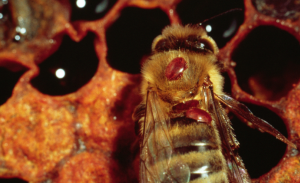Varroa mites are the latest finding in the plight of our agricultural (and hobby) European Honeybees. The Varroa Destructor is known to be a vector (carrier for diseases) for several viruses, including (but NOT limited to:)
- SacBrood
- Deformed Wing Virus (DWV)
- Black Queen Cell Virus (BQCV)
- Nosema Apis
- Chronic Bee Paralysis Virus (CBPV)
- Lake Sinai Virus 1, Lake Sinai Virus 2 (LSV1, LSV2)
- Acute bee paralysis virus (ABPV)
- Kashmir bee virus (KBV)
- Kakugo Virus
- Varroa Destructor Virus 1
- Israel acute paralysis virus (IAPV)
- Slow Bee Paralasys Virus (SBPV)
(list source: http://articles.extension.org/pages/71172/honey-bee-viruses-the-deadly-varroa-mite-associates )
While there is a rift in some beekeeping circles and groups about whether varroa mites can be managed with breeding “varroa resistant” or with “hygienic behavior” in bees – the fact remains that if bees are bred to coexist with – or to tolerate the varroa mites, then the colonies are subjected to a variety of possible diseases. Folks that are “treatment free” – should still perform varroa mite count tests – and not be disillusioned about the fact that mites are in your hives.
Another option is to use scientifically bred lines of queens that produce workers that do indeed perform hygienic behavior as a method of culling affected brood that has been infected with mite progeny (offspring) )from a reproductive foundress (female founding) mite. Research on this line of selective breeding can be found through Arista Bee Research Labs around the world.
A fantastic resource for learning to do mite-counts and various treatment methods is available at :
https://honeybeehealthcoalition.org/varroa/ (link will open in new tab or window) This has been updated in June of 2018 – and also includes links to videos showing how to perform mite-counts as well as several treatment methods.
Monitoring methods
Varroa mites can be monitored with any of several methods.
Alcohol Wash (or soap/water wash)
Sugar Roll
My personal take on monitoring methods is this: If you are going to be taking measurements for ANY metrics – you want as accurate of a sampling as possible. I do NOT believe that a sugar-roll will give you as accurate results as other methods. Yes – that means that some bees will be sacrificed for the greater cause of knowing your mite loads. If you’re going to collect data – make sure it’s ACCURATE data.
Treatment Methods
Dealing with varroa is a delicate and tricky proposition – when it is considered that we are trying to eliminate a “bug ON a bug”. And the host bug (apis mellifera – or honeybee) we want to thrive and be healthy.
A variety of treatment methods can be employed. I’ll also say, though – that some have proven to be ineffective. See this video link for a quick overview.
- VSH Lines of honeybees (Added Nov 2019)
- Oxalic Acid (OA) Vaporizing
- OA Fogging
- OA Drizzle
- OA Long Release (shop towel or Swedish sponge application)
- Thermal Heat Treatment of the hive (added Jan 2019)
- Apiguard
- Formic Acid
- Drone Brood Culling
- Brood Break
- Thymol (in various application methods)
- Screened bottom boards (ineffective – not a control – but as a monitoring method)
There are many more treatment methods that were found on the internet while researching treatment methods. Some – such as using screened bottom boards – have been dis-proven to be effective by themselves – however MAY be an aide to help another method be more effective. Regardless – it is recommended that you employ at least two methods for varroa control.
Newer methods of applying Oxalic Acid are being experimented with by several researchers, including Randy Oliver of Scientific Beekeeping, and others in Central Texas.
Randy’s OA results are shown here: http://scientificbeekeeping.com/oxalic-shop-towel-updates/
and his 2022 end-of-year report is here: https://scientificbeekeeping.com/2022-extended-release-oxalic-oae-update-part-2/
and importantly: https://scientificbeekeeping.com/instructions-for-extended-release-oxalic-acid/
(Jan 2019) – Experiments with using thermal heat treatments of the hive have proved effective for varroa management. In essence, the hive is heated to 106 deg. F for about 2 hours. This mimics the temperature that is achieved in nature that is associated with hive overcrowding for swarming action. This temperature also is that which the varroa cannot survive. When the hive temperature is raised to 106 deg. F. – the mites attached to the bodies, and those that are in the brood cells are killed – thus breaking the mite’s life cycle – and allowing the colony to move forward with fresh brood that is healthy.
Sources:
Honeybee Health Coalition: https://honeybeehealthcoalition.org/varroa/
Arista Bee Research Labs https://aristabeeresearch.org/
Randy Oliver – Scientific Beekeeping – https://scientificbeekeeping.com/2022-extended-release-oxalic-oae-update-part-2/
Mighty Mite Thermal Industries – https://www.beehivethermalindustries.com/how-it-works/
Dave Cushman – http://www.dave-cushman.net/bee/varroatreatment.html


Leave a Reply
You must be logged in to post a comment.